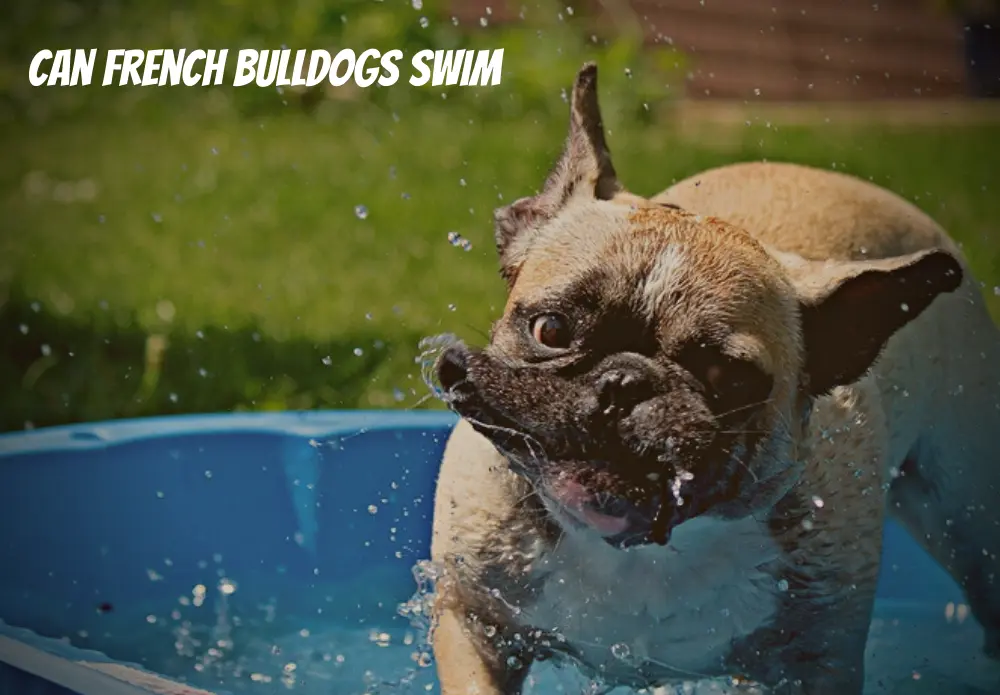It’s understandable why some people might believe that Frenchies can swim. The water is a great place to cool off because they easily become overheated, particularly in the summer.
It’s essential to remember that Frenchies cannot swim, despite how tempting it might be to let your dog cool off in the pool.
What Makes Dogs Good Swimmers?
The true reason swimming dogs are such good swimmers is their anatomical structure. A canine should possess these three qualities to be a great swimmer:
- Lengthy Muzzle
- Long legs
- A light, small head
These physical characteristics are crucial because a long muzzle and a small, light cranium aid in a dog’s ability to breathe naturally while swimming.
Additionally, the longs are essential for effective rowing. Look for breeds that naturally enjoy the water, such as Labrador Retrievers, Standard Poodles, Portuguese Water Dogs, and Standard Poodles.
You’ll notice these breeds have additional traits that make them superior swimmers.
Some dogs can even hold their breath for a lengthy period and have webbed feet for improved paddling. The French Bulldog appears like a chump in comparison to this.
Can French Bulldogs Swim?
These dogs were not designed for the water because of their small size, short legs, and lack of a snout.
Most will inevitably fall like a rock if ignored. Your French Bulldog won’t be able to swim for very long, even if they can currently swim a little. Frenchies, unlike other dog breeds like Labradors, cannot swim to the top once they begin to submerge.
Reasons French Bulldogs Are Bad Swimmers
But when it comes to swimming, Frenchies face an uphill fight. They don’t have the most swimming-friendly physical characteristics because of how they were created.
Breathing is Challenging for French Bulldogs
The term “brachycephalic syndrome” in canines means that their heads are shortened. Due to their wide and short skull bones, dogs with this disease appear to have “flattened faces.” The anatomy of the soft tissue structures alters as a result.
It is clear from the statement that French Bulldogs are brachycephalic canines. They aren’t the only ones, though. The Boxer, Pekingese, English Bulldog, Shih Tzu, Pugs, and other brachycephalic canine breeds are examples.
What effect does this bodily characteristic have on the Frenchies’ swimming prowess? Because they must tilt their heads upward to remain afloat in the water, brachycephalic dogs will struggle to stay afloat. Naturally, this implies that they will be moving almost vertically.
The canine must tilt its head more if its muzzle is shorter and flatter. Consequently, it becomes even more challenging to breathe while maintaining balance. For some Brachycephalic dogs, it’s manageable, but the Frenchie’s muzzle is “extra flat.”
Frenchies Are Heavy and Compact Dogs
Unquestionably, the French Bulldog is a powerful canine breed. Additionally, they frequently have heavy-boned canines with compact frames. In other terms, Frenchies don’t swim well because they have a high muscle-to-fat ratio.
Frenchies are small canines in comparison. A full-grown adult dog will measure 11 to 12 inches tall at the hip. But their weight can vary from 16 to 28 lbs, based on genetics and gender.
Muscle weighs a lot, which is why Frenchies are so hefty. As we previously stated, they are muscular dogs crammed into a small 11-inch canine body. Additionally, muscle sinks more frequently because it is thicker.
The greatest challenge to teaching your French Bulldog to swim safely. According to some owners, Frenchies have been known to descend vertically like stones suddenly.
French Bulldogs Have Short Legs
One of the few true dwarf canine breeds is the French Bulldog. We’re not mocking the Frenchie, that’s for sure. They truly carry the dwarfism gene, which is common in several well-known dog breeds. The canine will consequently grow unusually short legs.
Dogs with osteochondrodysplasia experience abnormal bone and joint growth and development. On the other hand, achondroplasia is a variant in which the bones do not develop to their maximum potential size.
Dwarfism is the term used to describe the outcome of achondroplasia, which can cause unusually short limbs. This characteristic of French Bulldogs can be very detrimental to swimming.
All canines will instinctively begin dog paddling when placed in water. Dogs can paddle in the water, but that doesn’t necessarily mean they can glide for a long time. After all, some canine breeds, like the Poodle, do not swim naturally.
The French Bulldog is trying to remain afloat with smaller paddles because of their short dwarf legs. I have to acknowledge that there are many breeds of short-legged dogs that can swim. But it can be challenging when you add all the other restrictions.
How to Teach a French Bulldog to Swim?
Certain French Bulldogs struggle with swimming more than others. It doesn’t necessarily follow that it’s difficult to instruct them in swimming. It is feasible and secures for them, provided they have the right tools and training.
Keep in mind that taking your Frenchie swimming can be frightening for them. Most canines find it overwhelming. You shouldn’t push your French Bulldog into the ocean. Having patience is a must because this procedure will take some time.
1. Get a Dog Life Jacket
The proper equipment must be purchased before teaching your Frenchie to swim. I only mean a canine life vest when I refer to equipment. I advise all proprietors to do this when starting the training, Frenchie or not.
Life jackets will not only give your French Bulldog more self-assurance, but they will also give owners peace of mind knowing that their pets will be safe. Even the American Kennel Club concurs with this recommendation.
2. Introduce the French Bulldog to Water
The next step, introducing your French Bulldog to water, might be the most important one. Although it might be alluring, it’s not a good plan to drop your dog into the shallow end and begin. You should acclimate them to water progressively.
Your Frenchie probably knows what water is already. If they’ve been taking showers, that is. Nevertheless, you should begin with smaller water areas and gradually advance to larger ones.
Start with a tiny kiddie pool or the bathtub. You simply want to put water on their feet at this early point. It’s not necessary to fill the Jacuzzi or pool. But be positive that some body parts are submerged.
Move to bigger bodies of water, like a lake or pool, after the dog has adapted. But it’s not yet time to bring them in. You only want your dog to “explore” the water in this stage by sniffing it quickly.
French Bulldogs are curious canines, so they probably won’t be fearful or intimidated initially. Before you realize it, their inquisitive nature will take over, and they’ll be inspecting the water!
Additionally, if you know exactly where the dog will be swimming, it is a good idea to transport him there. As a result, the canine will feel more secure and comfortable because they are more accustomed to the surroundings.
3. Getting Your Frenchie Into the Water
Your Frenchie is ready to swim now after days or even weeks of training. It’s crucial to begin at the lower end. And if at all feasible, seek out a location with warm water. Or at least it wasn’t ice frigid.
Remember to bring some of their favorite treats and toys to encourage your canines to enter the water. Entering the water yourself is the most effective method to do this. Dogs have faith in their owners because of this straightforward action.
Keep a treat in your hand while giving them the all-clear to enter the water and retrieve it. Try tossing their preferred playthings into the ocean. They frequently make an instinctual grab for it.
If this simple ruse succeeds, try dropping the object farther into the ocean. Similarly, you can get closer to them and entice them with food. Your Frenchie will be swimming in no time with a little perseverance!
Benefits of Swimming for Frenchies
All dogs, including their masters, can benefit from swimming! As a result, swimming has many fantastic health advantages for your French Bulldog.
Given their activity level, Frenchies require a fair bit of exercise. They need about an hour of activity per day. The absolute least is this. However, one minute of swimming is equivalent to four minutes of running, which is why swimming is so wonderful.
Naturally, spending more time swimming has several positive effects on one’s health, including improved heart and lungs, a faster metabolism, and decreased inflammation. Additionally, the circulation will maintain Frenchie’s glossy, smooth hair.
In addition, one of the most prevalent medical conditions in French Bulldogs is hip dysplasia. Swimming is a low-impact exercise that will strengthen your joints and muscles while reducing pain and inflammation.
The AKC claims that Frenchies are prone to fat. Numerous other health problems are correlated with being overweight. However, swimming is the greatest form of exercise for overweight dogs. They have a low chance of injury while burning a lot of calories!
Conclusion
If you’re wondering if French bulldogs can swim freely on their own, the answer is no. This does not imply that they can never appreciate the water, though. Your canine can play in the water in various safe ways without running the risk of drowning.
You can assist your Frenchie swim while ensuring their safety as a pet owner by taking various actions. If your dog can swim, you must take the required safety precaution of wearing a life jacket.
Pet parents must familiarize, train, and continuously watch over their dogs while in the water. When you are ready to take your dog swimming, you can unwind and have fun with your beloved canine companion.






